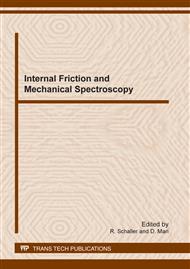[1]
Y.A. Chang, L.M. Pike, C.T. Liu, A.R. Bilbrey, D.S. Stone, Correlation of the hardness and vacancy concentration in FeAl, Intermetallics 1 (1993) 107-115.
DOI: 10.1016/0966-9795(93)90028-t
Google Scholar
[2]
E.P. George, I. Baker, Thermal vacancies and the yield anomaly of FeAl, Intermetallics 6 (1998) 759-763.
DOI: 10.1016/s0966-9795(98)00063-6
Google Scholar
[3]
D.G. Morris, The yield stress anomaly in Fe-Al alloys: the local climb lock model, Philos. Mag. A 71 (1995) 1281-1294.
DOI: 10.1080/01418619508244374
Google Scholar
[4]
K. Yoshimi, S. Hanada, Positive temperature dependence of yield stress in B2 FeAl, in: R. Darolia, J.J. Lewandowski, C.T. Liu, P.L. Martin, D.B. Miracle, M.V. Nathal (Eds. ), Structural Intermetallics, TMS, Warrendale, PA, 1993, pp.475-482.
Google Scholar
[5]
E.P. George, I. Baker, A model for the yield strength anomaly of Fe-Al, Philos. Mag. A 77 (1998) 737-750.
Google Scholar
[6]
D.G. Morris, M.A. Munoz-Morris, A re-examination of the pinning mechanisms responsible for the stress anomaly in FeAl intermetallics, Intermetallics 18 (2010) 1279-1284.
DOI: 10.1016/j.intermet.2009.12.021
Google Scholar
[7]
H. -E. Schaefer, B. Damson, M. Weller, E. Arzt, E.P. George, Thermal vacancies and high-temperature mechanical properties of FeAl, Phys. Stat. Sol. (a) 160 (1997) 531-540.
DOI: 10.1002/1521-396x(199704)160:2<531::aid-pssa531>3.0.co;2-7
Google Scholar
[8]
I.S. Golovin, H. Nauhäuser, A. Rivière, A. Strahl, Anelasticity of Fe-Al alloys, revisited, Intermetallics 12 (2004) 125-150.
DOI: 10.1016/j.intermet.2003.10.003
Google Scholar
[9]
J. Wu, F.S. Han, Z.Y. Gao, G.L. Hao, Q.Z. Wang, Anelasticity correlated to vacancies in B2 Fe-Al alloys, Phys. Stat. Sol. (a) 203 (2006) 485- 492.
DOI: 10.1002/pssa.200521404
Google Scholar
[10]
J. Wu, F.S. Han, Q.Z. Wang, G.L. Hao, Z.Y. Gao, The internal friction peaks correlated to the relaxation of atomic defects in Fe47Al53 alloy. Intermetallics 15 (2007) 838-844.
DOI: 10.1016/j.intermet.2006.10.037
Google Scholar
[11]
Y. Nishino, S. Asano, Determination of dislocation mobility from amplitude-dependent internal friction, Phys. Stat. Sol. (a) 151 (1995) 83-91.
DOI: 10.1002/pssa.2211510109
Google Scholar
[12]
S. Asano, Theory of nonlinear damping due to dislocation hysteresis, J. Phys. Soc. Jpn. 29 (1970) 952-963.
DOI: 10.1143/jpsj.29.952
Google Scholar
[13]
S. Asano, Analytical expressions of intrinsic internal friction based on damping data under inhomogeneous strain, Philos. Mag. 30 (1974) 1155-1159.
DOI: 10.1080/14786437408207267
Google Scholar
[14]
R.L. Fleischer, Substitutional solution hardening, Acta Metall. 11 (1963) 203-209.
Google Scholar


